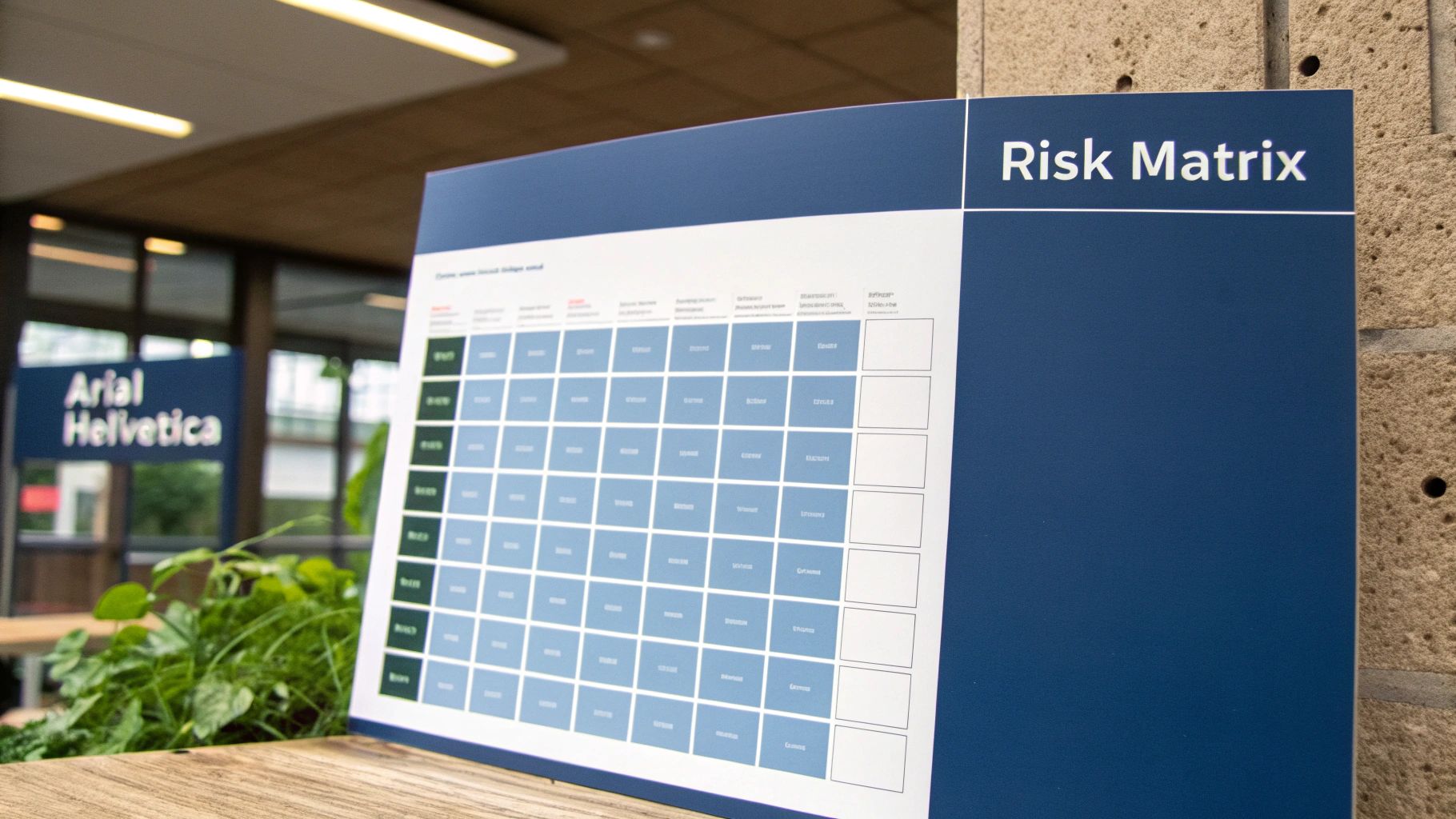Risk Assessment Matrix Template: Boost Your Management
Why Risk Assessment Matrices Matter
The ability to manage and assess risk is critical for business success. Whether you're launching a product or overseeing a major project, understanding potential risks is essential. A risk assessment matrix template provides the structure needed to evaluate and prioritize risks systematically based on their probability and potential impact.
Moving beyond gut feelings, a risk assessment matrix enables data-driven decisions about risk. For complex projects with multiple potential issues, this systematic approach ensures no risks are overlooked or overemphasized. The matrix brings much-needed clarity and organization to risk management.
Benefits of Using a Risk Assessment Matrix
Key advantages of implementing a risk assessment matrix include:
- Clear Risk Visualization: The matrix format makes risks easy to understand and share across teams
- Smart Prioritization: Scoring risks by likelihood and impact helps identify which need immediate action
- Better Team Alignment: Teams gain a shared framework for discussing and analyzing risks together
- Evidence-Based Choices: Decisions stem from concrete data rather than assumptions
Historical data analysis strengthens this structured approach. The process involves identifying risks, determining their probability and impact, and calculating risk scores. Organizations typically use frameworks like ISO, SOC, and NIST to analyze past events and inform future risk scoring. Learn more in Sprinto's guide to risk assessment matrices.
Types of Risk Assessment Matrices
Different matrix types serve various needs and complexity levels:
- 3x3 Matrix: A basic overview suitable for simpler projects and initial assessments
- 5x5 Matrix: More detailed evaluation ideal for complex projects requiring nuanced analysis
- Custom Matrices: Organizations can adapt matrices with industry-specific factors and criteria
The right matrix choice depends on your context and detail needs. A small business may find a 3x3 matrix sufficient, while large enterprises often need a detailed 5x5 format. But the core purpose remains consistent - to objectively assess risks based on concrete data to enable proactive risk management and better outcomes.
Building Your Professional 5x5 Risk Matrix
Creating an effective risk assessment matrix requires methodical planning and well-structured components. The 5x5 risk matrix format offers a more detailed analysis compared to basic models. Let's explore how to build a professional 5x5 risk assessment matrix template step by step.
Defining Likelihood and Impact Scales
The success of a risk assessment matrix template depends on having clear definitions for likelihood and impact scales. For likelihood, use specific probability ranges - for example, "Very Unlikely (1-10% chance)" to "Almost Certain (91-100% chance)". Impact scales should specify actual consequences, from "Negligible (minimal disruption)" to "Catastrophic (business failure)".
The 5x5 grid provides a comprehensive view by measuring two key dimensions: likelihood levels (from 'Very Unlikely' to 'Almost Certain') and impact levels (from 'Negligible' to 'Catastrophic'). Learn more about building a risk matrix. This expanded format enables more precise risk evaluation compared to simpler 3x3 matrices.
Examples of Effective Category Definitions
Consider how a software company might assess data breach risks. A "Likely" rating could mean "documented intrusion attempts within 12 months," while "Significant Impact" might indicate "exposure of customer data resulting in fines and reputation damage." These concrete definitions help keep scoring objective and improve communication.
For a construction firm evaluating workplace safety, "Possible" could mean "comparable incidents in the industry over 5 years," with "Moderate Impact" defined as "temporary delays and higher insurance costs." Clear categories enable better-informed decisions.
Developing a Scoring System
The scoring methodology involves assigning numeric values (1-5) to likelihood and impact levels. Multiply these scores to calculate the overall risk rating - for instance, likelihood 4 x impact 3 = risk score 12. This creates clear risk rankings to guide mitigation priorities. You may find helpful: How to master third-party risk assessment.
| Impact Level | Likelihood Level | Risk Score | Required Action |
|---|---|---|---|
| Catastrophic (5) | Almost Certain (5) | 25 | Immediate action required |
| Major (4) | Likely (4) | 16-20 | High priority response needed |
| Moderate (3) | Possible (3) | 9-15 | Plan mitigation measures |
| Minor (2) | Unlikely (2) | 4-8 | Monitor and review |
| Negligible (1) | Very Unlikely (1) | 1-3 | Note and track |
Visualizing Your 5x5 Risk Matrix

The visual representation of your risk assessment matrix template uses color coding for instant recognition - red for high risks (16-25), yellow for medium risks (9-15), and green for low risks (1-8). This helps teams quickly understand risk levels and focus resources on critical areas. A well-designed 5x5 risk matrix equips organizations to manage risks proactively and make better decisions.
Mastering Risk Score Calculations

Creating an effective risk assessment matrix template requires a clear and systematic scoring approach. This process converts qualitative risk evaluations into measurable data points, allowing teams to compare and prioritize risks objectively.
Understanding the Calculation Process
The most widely used method for calculating risk scores is multiplying likelihood by impact ratings. This highlights significant risks by emphasizing high values in both categories. For example, if a risk has a likelihood rating of 4 and an impact rating of 5, its total score would be 20 - clearly marking it as high priority. The Vertex42 Risk Assessment Matrix template demonstrates this approach, with scores ranging from 1 to 25.
Visualizing Risk Scores: Color-Coding
Risk scores come alive through strategic color-coding. Most risk assessment matrices follow a simple traffic light system: green indicates low risk, yellow shows medium risk, and red highlights high-risk items. This visual system helps teams and stakeholders quickly spot critical areas needing attention during presentations and reviews.
Developing a Scoring Framework That Works
Your scoring system must align with your organization's risk tolerance levels and goals. What counts as "medium" risk varies between companies based on factors like:
- Industry regulations
- Financial position
- Overall risk appetite
Some risks may need higher weighting based on their potential impact. For instance, organizations handling sensitive data often place extra emphasis on cybersecurity risks.
Example: Applying the Scoring System
Consider this real-world example: A manufacturing company evaluates equipment failure risk. They rate a specific machine malfunction with a likelihood of 4 ("Likely") and impact of 3 ("Moderate"). This creates a risk score of 12, placing it in the yellow zone that requires planned action. If the impact rating increased to 5 ("Critical"), the score would jump to 20, demanding immediate intervention.
Moving Beyond Basic Calculations
While multiplication is common, it's not the only valid approach. Many organizations create custom formulas or weighted systems that better match their needs. The key is selecting a method that:
- Accurately shows risk priorities
- Provides clear direction for action
- Fits your organization's decision-making process
By understanding these calculation methods, teams can shift from reactive problem-solving to proactive risk management, improving their chances of project success.
Leveraging Data for Smarter Risk Assessment
A risk assessment matrix template needs to grow and adapt alongside your organization. Using data effectively transforms guesswork into fact-based risk management.
Gathering and Analyzing Relevant Data
Creating a data-driven risk assessment starts with getting the right information. This includes reviewing past incidents, near-misses, audit results, and industry standards. Equipment failure records help predict future problems and their impact. When data flows in from multiple departments like IT, operations, and finance, you get a complete view of organizational risks.
Establishing Meaningful Metrics
Clear metrics make data useful for decision-making. Rather than vague "high" or "low" impact labels, use specific measures. A high impact event could mean $100,000+ in losses or service disruptions over 24 hours. This precision helps your risk assessment matrix template produce objective, consistent results.
Maintaining Dynamic Matrices
Risk landscapes change constantly, so your matrix must adapt too. Check and update your data inputs regularly as your operations, industry, and regulations evolve. An outdated matrix loses value quickly. New cyber threats, for example, require fresh data and risk evaluations. Risk assessment often combines historical analysis with expert input. For instance, NASA's Engineering and Safety Center (NESC) created a 5x5 Risk Matrix Scorecard using both numbers and expert judgment.
Combining Historical Insights With Expert Judgment
While data guides the process, expert knowledge adds vital perspective. When you blend data analysis with team experience, your risk assessment improves. Historical data might show low risk for an incident, but experts could spot new factors increasing its likelihood. This balanced approach creates a more accurate risk assessment matrix template. Learn more about data classification policies.
Building Effective Data Collection Systems
Use tools that make data collection and integration simple. This could include automated reporting, central databases, and visual dashboards. Good systems save time and boost accuracy in risk assessment data. Quality data leads to better risk management choices through a more effective matrix.
Making Your Risk Matrix Work in Real Life

A risk assessment matrix only provides value when it becomes an integral part of your daily operations. Success requires proper team training, regular reviews, and adapting the system as your organization evolves.
Integrating the Matrix into Daily Operations
Make risk assessment a natural part of your team's workflow by including it in project planning, status updates, and key decisions. Project teams should evaluate potential risks using the matrix before starting new initiatives and reassess risks during regular check-ins. This ensures risk management becomes a continuous practice rather than a one-time exercise.
Training Your Team
Every team member needs to know how to properly use the risk assessment matrix. Provide thorough training on scoring risks, understanding impact levels, and taking appropriate actions. Clear guidelines help prevent common mistakes, like incorrectly classifying low-impact issues as high-risk items. You might be interested in: How to master document management best practices.
Establishing Review Cycles
Set up regular risk review sessions based on your business needs - this could be monthly, quarterly or annual reviews. Use these sessions to evaluate existing risks, identify emerging threats, and update your assessments. Having a structured review process keeps your risk matrix current and relevant.
Scaling Across Departments and Locations
As your company grows, maintaining consistent risk assessment practices becomes more complex. Create detailed guidelines for using the risk assessment matrix across different teams and office locations. Consider setting up a central risk management team or implementing standardized software to ensure alignment.
Overcoming Implementation Challenges
Teams may initially resist using a risk matrix, viewing it as extra work. Combat this by clearly showing how it improves decision-making and project outcomes. Keep the matrix updated by establishing clear data collection processes and review schedules.
Implementation Checklist
Here's a step-by-step guide for rolling out your risk matrix effectively:
| Phase | Actions | Resources Needed | Timeline |
|---|---|---|---|
| Planning | Define scope, objectives, and stakeholders. Develop a communication plan. | Project team, risk management software | 1-2 weeks |
| Development | Create the risk matrix template, define criteria, and train the team. | Risk management team, training materials | 2-4 weeks |
| Implementation | Integrate the matrix into workflows, conduct initial risk assessments. | Project teams, risk management software | Ongoing |
| Monitoring & Review | Regularly review and update the matrix based on new data and feedback. | Risk management team, performance data | Ongoing |
Following these practical steps helps organizations successfully implement their risk assessment matrix. This creates a data-driven approach to managing risks that leads to smarter decisions and better project results.
Proven Strategies and Common Mistakes

A risk assessment matrix template helps create a strong foundation for risk management, but getting real value requires careful implementation and ongoing updates. Success depends on following proven practices while avoiding key pitfalls.
Strategies for Success
Effective risk management requires more than just completing a template. Here are key approaches used by successful organizations:
- Regular Reviews: Your risk environment constantly changes. Schedule quarterly reviews of your risk assessment matrix template to keep it current.
- Include Key People: Work with managers and staff across departments to gain different viewpoints and build support for the process.
- Set Clear Standards: Create specific definitions for risk levels. For example, define "high impact" with measurable criteria like "financial loss over $50,000."
- Keep Good Records: Maintain detailed documentation of assessments, decisions, and response plans. This creates accountability and helps future planning.
- Make Ongoing Updates: Treat your risk assessment matrix template as a work in progress. Evaluate how well it works and adjust based on experience.
Common Pitfalls to Avoid
Watch out for these frequent mistakes that can reduce the effectiveness of risk assessment:
- Missing Rare but Serious Risks: While common threats need attention, don't ignore low-probability events that could cause major damage if they happen.
- Random Risk Scoring: Without defined criteria and proper training, risk ratings become guesswork rather than objective assessment.
- Not Updating the Matrix: A risk assessment matrix template must evolve. Regular updates help capture new risks and incorporate lessons learned.
- Limited Input: Not consulting with relevant teams leads to blind spots in risk identification and poor follow-through on mitigation plans.
- Making it Too Complex: While thoroughness matters, an overly detailed matrix becomes hard to use. Find the right balance of completeness and usability.
Example: Adapting to Change
Consider a manufacturer relying on one key supplier. Their initial risk assessment matrix template may show low supply chain risk. But changes like political issues or supplier financial problems could quickly increase that risk level. Regular matrix reviews help spot emerging threats early, allowing time to find backup suppliers.
By following proven methods and avoiding common errors, organizations can get the most value from their risk assessment matrix template and build strong risk management practices that protect their business.
Ready to improve your document creation and risk management? Whisperit offers AI-powered dictation and text editing tools to help you work more efficiently. Learn more about Whisperit and how it can benefit your organization.